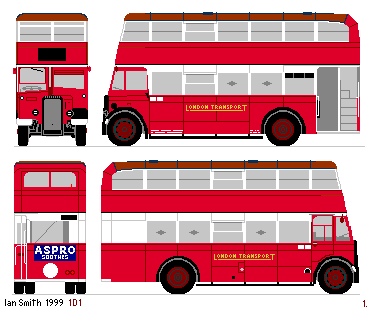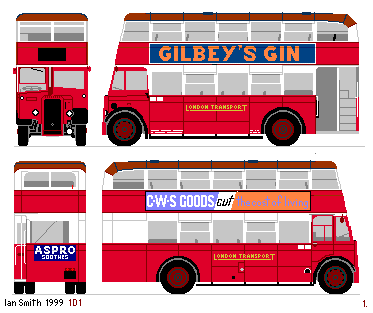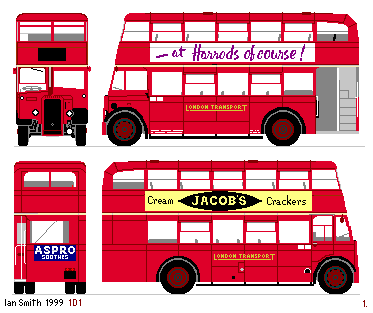
The LONDON TRANSPORT D classThis page created 29th November 1999, by Ian SmithThe first lowbridge Daimlers: D1-D8, 1D1There are not many types of London bus with an association with a single route, but the lowbridge Daimlers were one. They spent their entire working lives with London Transport on the 127, a short almost circular route between Morden Station, Wimbledon, and South Wimbledon Station. They were later allowed to work occasionally on the 152, and on the Wimbledon tennis and Epsom Race Course specials, but that was it.The reason for the prohibition on other working was their height: 13 feet 4.8in. London Transport liked its lowbridge buses to be 13ft 3in or less, and had turned down the opportunity to get thirteen lowbridge utility Guys because they were thirteen feet six. But the Daimler chassis were an inch and a quarter lower, making a significant difference. The 127 had started the war as the singledecker route , but had been converted to mixed single and lowbridge operation when LT built its batch of lowbridge bodies for STLs, due to heavy wartime demand. The railway bridge at Worcester Park station allowed the transit of the offered Daimlers, so LT went for them, its first Daimlers since before the war. Construction The chassis were by Daimler, a wartime version of its prewar chassis,
fitted with an AEC 7.7litre engine and a preselector gearbox.
These features made them far more popular than the crash-gearbox Guys
to the crews who had to operate them.
The chassis were by Daimler, a wartime version of its prewar chassis,
fitted with an AEC 7.7litre engine and a preselector gearbox.
These features made them far more popular than the crash-gearbox Guys
to the crews who had to operate them.
The bodies were by Duple, a London firm, and were to the full austerity lowbridge specification. The roof featured a full lobster-back treatment, there were just four opening windows, and a hopper ventilator on the front of the top deck. The registration plate, unilluminated, was carried on the rear offside, but above the platform window, with just a rear and brake light pair lower down. The lowbridge arrangement was achieved with a sunken gangway on the offside, with the inevitable four-in-a-row seating upstairs. With wooden slatted seating, this produced a mass sideways slide on corners, I am told. The front display was the standard utility type, opening from the inside, not the London utility-standard external opener.
Livery was red and white, with a narrow black band between above the windows.
Mudguards were also black. The roof was chocolate brown (red oxide), and
included some of the lobster-back.
The rest of the lobster-back, and the window surround, were red.
When delivered they had anti-splinter netting on most of the lower deck windows and on the lower halves of upper deck windows.
Into serviceThe lowbridge Daimlers went into service on route 127 in April and May 1944. It was not long before the cessation of manned air attacks allowed the relaxation of the blackout rules, and a slight relaxation in the austerity arrangements for buses. An early move was the installation of a number plate and rear light panel.
Improved ventilation came with the installation of more opening windows on both decks.
An early move was the installation of a number plate and rear light panel.
Improved ventilation came with the installation of more opening windows on both decks.
But upholstered seats had to wait until their first overhaul, between July 1947 and April 1948. At the same time they were repainted, losing their unique black trim line between the decks in the process. They also gained a white window surround at the top rear. Chiswick also painted the cast radiator shells red, whereas the new buses and garage repaints saw them black. After their overhauls it was noticed that the six buses sported four different styles between them!
 They continued on the 127, but now were allowed to work on the Wimbledon tennis specials,
and the Epsom Races specials. Apart from these, route 152 was added to their allowable routes,
and was added to the blinds in mid 1948.
They continued on the 127, but now were allowed to work on the Wimbledon tennis specials,
and the Epsom Races specials. Apart from these, route 152 was added to their allowable routes,
and was added to the blinds in mid 1948.
Another overhaul, between August 1950 and July 1951 saw them repainted into overall red, with a cream band. They remained at Merton on the 127 until December 1952, when they were all replaced by new RLH buses.
Six of the eight went on the January boat to Ceylon,
after North of Leeds had appealed to LT for help,
having been told by South Western Omnibus Co.
that a boat was already on its way!
|
 Bus Stop
Bus Stop index.
index. high Duples.
high Duples.